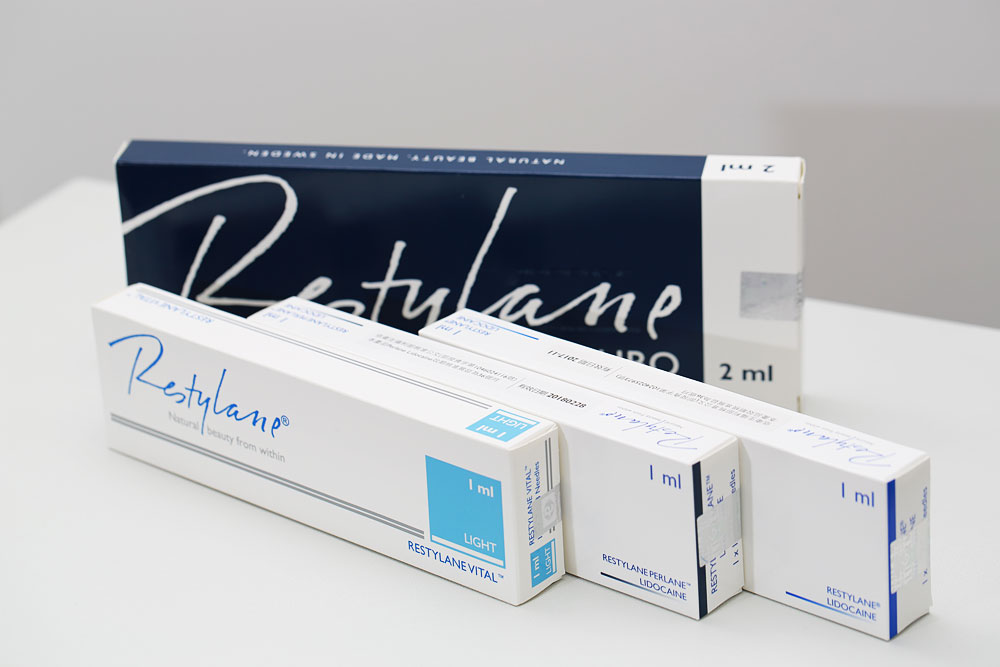Hyaluronic Aacid Injection
Hyaluronic acid, also called hyaluronan, is a macromolecular glycosaminoglycan distributed throughout the human skin and connective tissues and preserves water and plumps and lubricates tissues to make the skin look hydrated and delicate with an elastic youthful appearance. Nevertheless, as the skin starts aging, the endogenous hyaluronic acid gradually drains away from the epidermis and causes dry, atrophic, or depressed skin, resulting in fine lines (static wrinkles) or deep grooves (such as lacrimal groove, nasolabial lines, or marionette lines). This necessitates exogenous injections to supplement hyaluronic acids necessary for the skin to delay or treat skin aging. At present, hyaluronic acid injection for micro-plastics is different from that for moistening or articular lubrication and is derived from bacterial fermentation and belongs to the non-animal stabilized hyaluronic acid-grade hyaluronan with a high safety and biocompatibility. Besides, its semi-solid gel properties effectively fill the depressions of skin wrinkles and sustain stable results. Generally, if the different formulations of hyaluronic acids are accurately understood in terms of use and injected in an appropriate way, the results can be maintained for approximately 6 months.
Our clinic utilizes injectable hyaluronic acids from Q-Med (a Swedish company), which are the most extensively used worldwide, and due to differences in the molecular size of hyaluronic acids and bonds, numerous formations are optional for each product series. Generally, the smaller the molecules are, the more superficial the dermal layer where the hyaluronic acids will be injected into, which mainly aim to smooth static wrinkles and demonstrate relatively temporary results. Large molecular-weight hyaluronic acids are predominantly injected into deep subcutaneous tissues or lipid layers. They are widely used for filling skin depressions, which effectively improves deep nasolabial lines or depressions at the cheeks or temples. Additionally, they are applied for injection rhinoplasty or lip augmentation and other contour sculpting, the results of which relatively stable and long lasting. Our clinic offers the following hyaluronic acids in different formulations to patients for different body parts and demands:
Macrolane
Macrolane is injected into the subcutaneous fat layer and has numerous formulations and capacities. It is mainly used for filling large areas of body parts such as chest defects, funnel chest, buttock depression, or traumatic muscular atrophy depression. The results last for over a year.
Sub-Q
Sub-Q is injected into the fat layer or subcorium and is primarily used to fill large-area depressions or defects on the face such as depression at the submalar triangle or both cheeks or temples. The results last for 6 months to a year.
Perlane
Perlane is be injected into the subcorium and is mainly used to sculpt the contour of hard parts (such as for injection rhinoplasty and jaw plastics), fill relatively deep grooves (such as nasolabial folds or kitten lines), and improve marionette folds.
Restylane
Restylane is injected into the superficial dermis to primarily sculpt soft tissues and skin lines such as the nasal tip, aegyo sal, earlobes, lips, lacrimal grooves, frowning wrinkles, nasolabial folds, and marionette lines. The results last for approximately 6 months.
Restylane Vital light
Restylane Vital Light is injected into the most superficial epidermis to improve the tiny periocular fine lines, perioral lines, and other static wrinkles. It has the shortest efficacy and is absorbed in approximately 4–6 months.
All the aforementioned hyaluronic acids of different molecular weights need to be injected in an appropriate way to ensure the results and effect duration. The injection of low molecular weight formulations into the deep skin layer results in rapid absorption and temporary effects, while the injection of high molecular weight hyaluronic acids into the superficial layer leads to skin mass or unevenness, which spreads to the adjacent area, thus affecting treatment results. Moreover, as part of human normal skin tissues, hyaluronic acids sometimes coexist with the skin and are not absorbed or their durability is affected due to individual physiques and lifestyles. Patients should understand and accept these unpredictable variables before treatment.
Duration Of Treatment Results
On Average
General Instructions
- Avoid injection with other medicines to avoid rejection or infection.
- It is contraindicated for patients with acute or infectious skin diseases at the affected area or immune disorders.
- Avoid contact with an extreme alternate warm–hot or cold–hot environment for 1 month after the injection to avoid excess absorption of hyaluronic acids.
- Do not frequently press the affected site after the injection to prevent drug spreading.
- Overdose injection should be avoided in patients with a subcutaneous prosthesis to prevent skin inflammation or necrosis.
Site Of Injection
- Sculpting of face contour (such as rhinoplasty and jaw plastics)
- Skin plumping (such as lip augmentation or filling of cheek depressions)
- Skin grooves and lines (such as nasolabial folds, marionette lines, or lacrimal grooves)
- Static wrinkles (such as lip wrinkles, frowning wrinkles, or periocular fine lines)
Potential Complications
- Skin redness
- Masses
- Uneven surface
- Reagent spreading
- Premature absorption
- Skin infection

